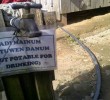DAVAO CITY—The abalone industry could flourish in Mindanao due to locations suitable for growing the tropical shelled species, a high-value aquaculture product.
“Mindanao could potentially produce a lot of abalone due to favorable sites, weather, and availability of seaweeds,” said Vincent Encena II, an abalone specialist from the Southeast Asia Fisheries Development Center Aquaculture Department (SEAFDEC-AQD) a research and development institution based in Tigbauan, Iloilo.
Considered a delicacy in Asia, the abalone is a single-shelled, herbivorous marine mollusk found under rocks and coral rubble and is known for its sweet, firm meat.
Encena said Misamis Oriental, Surigao del Sur and the Autonomous Region for Muslim Mindanao (ARMM) particularly Tawi Tawi and Sulu group of islands, where tropical abalone wild stocks may be found, are potential areas for prospective abalone farms.
Encena also mentioned that Siargao Island, Sarangani province and Gen San, with its numerous tuna canning facilities, have the biggest potential areas for abalone growing and processing, respectively. The average abalone production capacity of the identified potential Mindanao areas range from 10 to 50 tons per year, Encena said.
According to Encena, these potential abalone sites have available areas for sea-based farms and access to processors and major abalone markets. These areas are also rich in seaweeds, the staple feed to abalone.
The tropical abalone species found in Southern Japan to northern Australia is the donkey’s ear abalone, Haliotis asinina, locally known as “lapas” in Cebuano or “sobra-sobra” in Ilonggo.
Encena said that canned abalone is one of the preferred product forms in the Chinese market, which is the biggest market for abalone in the world. Each can of abalone may be sold for 750 to 800 pesos per can in the local market and more if sold in the export market, he added.
He said that while a container load of canned tuna is valued at 40,000 US dollars, the same container load of canned abalone would value at around 390,000 US dollars.
However, Encena said that wild stocks of abalone in the Philippines are in decline, due to unregulated harvests and overfishing. He said abalone needs to be farmed or cultured for the future need of the processing industry.
Since most of the tuna canneries in GenSan are not operating fully due to the lack of raw material for canning like tuna, a processing line for abalone may be incorporated in the tuna cannery line with minimum investment, Encena suggested. He added that it was a way for overhead expenses on tuna canneries to be reduced and a high-value canned product, other than tuna, to be produced.
“Mindanao must conduct a more thorough assessment of sites with potential for abalone culture,” he said.
Encena said commercial-scale abalone hatchery and commercial-scale abalone demo-farm must be established for prospective abalone sites in Mindanao to succeed. He added that value-added products from abalone meat should be studied.
The Philippines, in 2006 was the top exporter of frozen abalone to Hong Kong, with around 30 percent, while Australia got around 23 percent of the frozen market. Philippine abalone products are also exported to Taiwan, Japan, Korea and Singapore.
In a presentation made by Encena during the Bimp-Eaga High Value Aquaculture Business Conference held in General Santos City last month, Encena showed the value of world abalone market is pegged at 1 billion US dollars. However, demand for abalone has temporarily decreased due to global economic downturn.
The business conference was aimed at increasing and expanding private enterprises on high-value aquaculture in Bimp-Eaga through the active promotion of joint ventures between and among Eaga members, investment and trading, and export of high-value seafood to target markets.
Encena said that Bimp-Eaga must adopt a unified approach in terms of abalone development in the region through stock assessment of abalone and seaweed, assessment of suitable sites, abalone breeding and culture centers.
He recommended a Bimp-Eaga marketing strategy for various product forms of abalone such as abalone congee and abalone in different sauces and look at non-traditional markets like Europe and the US. (MEDCo)
IMPORTANT NOTICE: INBOX is an archive of press releases, statements, announcements, letters to the editors, and manifestos sent to Davao Today for publication. Please email your materials to davaotoday@gmail.com. Davao Today is not responsible for the content of these materials. The opinion expessed in these items does not reflect those of Davao Today and its staff. Please refer to our terms of use/disclaimer.










